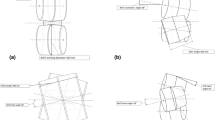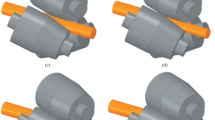Computer simulation of three- and four-high screw rolling of titanium nickelide billets was carried out using QForm finite-element software. Based on the results of the computer simulation, the parameters of the stress–strain and kinematic states are compared. The paths of several points located on the billet radius during rolling were plotted. The normalized Lode angle at these points was calculated. The spread of values of the normalized Lode angle in three-high rolling is wider by a factor of 5 than in four-high rolling. The spread of values of the normalized mean stress is almost the same for both types of rolling. The increment of strain per 1 mm of the path in the deformation zone during four-high screw rolling is less by 43% than during three-high rolling. This suggests that the strain state is softer during four-high rolling and more preferable for rolling low-ductility and difficult-to-form materials. It was found out that the qualitative change in the total velocity of the tracked points in the deformation zone is the same for both types of rolling: the total velocity of the central layers of the billet increases, while the total velocity of the surface layers decreases.









Similar content being viewed by others
References
V. Sheremetyev, K. Lukashevich, A. Kreitcberg, A. Kudryashova, M. Tsaturyants, S. Galkin, V. Andreev, S. Prokoshkin, and V. Brailovski, “Optimization of a thermomechanical treatment of superelastic Ti–Zr–Nb alloys for the production of bar stock for orthopedic implants,” J. Alloys and Compounds, 928, 167143 (2022).
V. Sheremetyev, A. Kudryashova, V. Cheverikin, A. Korotitskiy, S. Galkin, S. Prokoshkin, and V. Brailovski, “Hot radial shear rolling and rotary forging of Metastable Beta Ti-18ZR-14Nb (at. %) alloy for bone implants: Microstructure, texture and functional properties,” J. Alloys and Compounds, 800, 320–326 (2019).
V. A. Sheremet’ev, A. A. Kudryashova, X . T. Dinh, S. P. Galkin, S. D. Prokoshkin, and A. Brailovskii, “Advanced technology for preparing bar from medical grade Ti-Zr-Nb superelastic alloy based on combination of radial-shear rolling and rotary forging,” Metallurgist, 63, 51–61 (2019).
I. B. Ratochka, I. P. Mishin, O. N. Lykova, E. V. Naydenkin, and N. B. Varlamova, “Structural evolution and mechanical properties of a VT22 titanium alloy under high-temperature deformation,” Russian Physics J., 59, 397–402 (2016).
I. V. Vlasov, Yu. F. Gomorova, A. V. Yakovlev, and E. V. Naidenkin, “Change of the impact strength of VT8 and VT14 titanium alloys after screw rolling and controlled cooling,” in: Abstracts of Papers Read at Int. Conf. on Physical Mesomechanics: Materials with Multilevel Hierarchical Structure and Intelligent Production Technologies [in Russian], Tomsk, September 6–10 (2021), pp. 137–138.
V. S. Yusupov, B. A. Romantsev, M. M. Skripalenko, V. A. Andreev, A. V. Erokhin, A. A. Myshechkin, and A. E. Kasumov, “Modeling the stress–strain state of workpieces in screw rolling,” Stal’, No. 6, 17–19 (2021).
A. V. Vlasov, S. A. Stebunov, S. A. Evsyukov, N. V. Biba, and A. A. Shitikov, Finite-Element Modeling of Stamping and Forging Processes [in Russian], Izd. MGTU im. N. E. Baumana, Moscow (2019).
M. M. Skripalenko, S. P. Galkin, H. J. Sung, B. A. Romantsev, T. B. Huy, M. N. Skripalenko, L. M. Kaputkina, and A. A. Sidorow, “Prediction of potential fracturing during radial-shear rolling of continuously cast copper billets by means of computer simulation,” Metallurgist, 62, 849–856 (2019).
Y. Bai, X. Teng, and T. Wierzbicki, “On the application of stress triaxiality formula for plane strain fracture testing,” J. Eng. Mater. Technol., 131 (2009).
Z. Pater, J. Tomczak, T. Bulzak, L. Wojcik, and M. M. Skripalenko, “Prediction of ductile fracture in skew rolling processes,” Int. J. Machine Tools and Manufacture, 163, 103706 (2021).
Z. Pater, “A comparison of two-roll and three-roll cross wedge rolling processes,” Adv. Sci. Technol. Res. J., 17, No. 1, 252–266 (2023).
V. L. Kolmogorov, Metal-Forming Mechanics [in Russian], Izd. UGTU-UPI, Ekaterinburg (2001).
A. V. Belevich, Modelling the Plasticity and Strength of Steels and Alloys: Practical Technological Mechanics [in Russian], Izd. VlGU, Vladimir (2005).
A. A. Bogatov, O. I. Mizhiritskii, and S. V. Smirnov, Plasticity Margin in Metal Forming [in Russian], Metallurgy, Moscow (1984).
Y. Bai and T. Wierzicki, “A new model of metal plasticity and fracture with pressure and Lode dependence,” Int. J. Plasticity, 24, 1071–1096 (2008).
Tran Ba Huy, Development and Study of Screw Rolling in a Four-High Mill Based on Physical and Computer Simulation [in Russian], PhD Thesis, NITU MISiS, Moscow (2019).
V. K. Vorontsov, P. I. Polukhin, V. A. Belevitin, and V. V. Brinza, Experimental Methods of Solid Mechanics (Technological Forming Problems) [in Russian], Metallurgiya, Moscow (1990).
V. A. Belevitin, Development and Improvement of Methods of Experimental Mechanics for Optimization of Forming Processes [in Russian], DSci Thesis, Verkhny Ufaley, Chelyabinsk Region (1997).
T. Bajor, A. Kulakowska, and H. Dyja, “Analysis of the rolling process of alloy 6005 in a three-high skew rolling mill,” Materials, 13, 1114 (2020).
M. M. Skripalenko, B. V. Karpov, S. O. Rogachev, L. M. Kaputkina, B. A. Romantsev, M. N. Skripalenko, T. B. Huy, V. A. Fadeev, A. V. Danilin, and Y. A. Gladkov, “Simulation of the kinematic condition of radial shear rolling and estimation of its influence on a titanium billet microstructure,” Materials, 15, 7980 (2022).
Author information
Authors and Affiliations
Corresponding author
Additional information
Translated from Metallurg, Vol. 67, No. 10, pp. 82–88, October, 2023. Russian DOI https://doi.org/10.52351/00260827_2023_10_82.
Rights and permissions
Springer Nature or its licensor (e.g. a society or other partner) holds exclusive rights to this article under a publishing agreement with the author(s) or other rightsholder(s); author self-archiving of the accepted manuscript version of this article is solely governed by the terms of such publishing agreement and applicable law.
About this article
Cite this article
Skripalenko, M.M., Romantsev, B.A., Yusupov, V.S. et al. Computer-Simulation Assessment of the Stress–Strain and Kinematic States of a Titanium Nickelide Billet during Screw Rolling. Metallurgist 67, 1523–1531 (2024). https://doi.org/10.1007/s11015-024-01645-1
Received:
Revised:
Accepted:
Published:
Issue Date:
DOI: https://doi.org/10.1007/s11015-024-01645-1




